The Rise and Fall of Hi-Fi AM & AM Stereo
…plus a look at two AM Stereo Radios and some Wideband AM Mono Radios
*Radio Shack TM-152 AM Stereo Component Tuner
*Sony SRF-A1 AM Stereo Walkman
*Aiwa FR-C30U/FR-C33 Wideband Portables
and a comparison with other models offering Wide Bandwidth AM options.
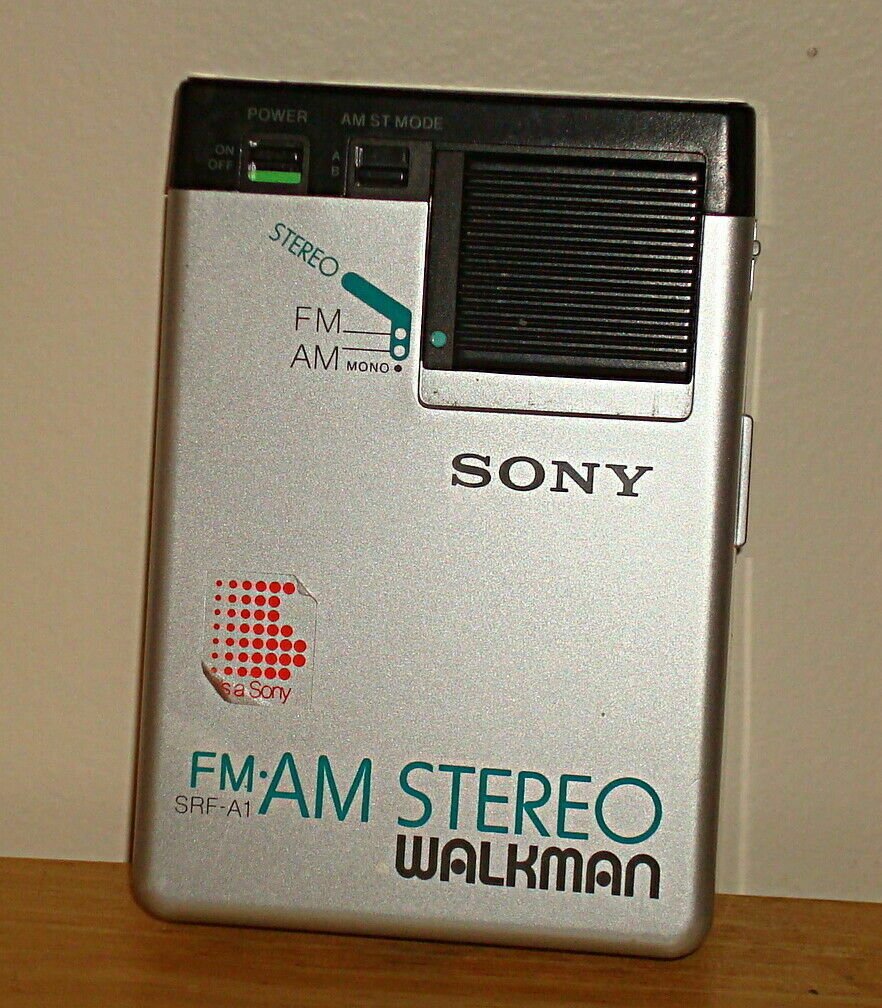
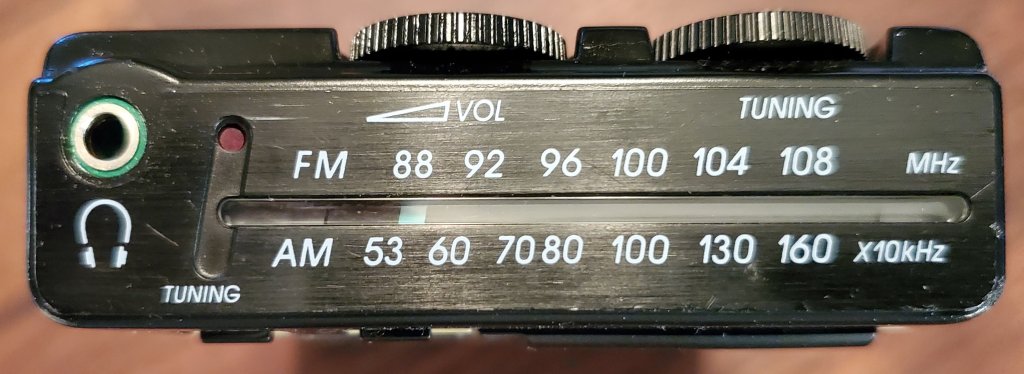
Recently a reader graciously sent me two radios for evaluation – the much sought-after Sony SRF-A1 AM Stereo Walkman and the Aiwa FR-C30U. Manufactured around 1983 the Sony was one of several Stereo AM receivers available as AM Stereo was being promoted. The sender was particularly interested in my feelings about these with regards to their wideband sound quality and some reports which once circulated claiming that AM Stereo “sounded better” than FM. Having worked at two AM Stereo stations I had several recollections of our experiences with AM Stereo in its heyday, and from that time I still had my Realistic TM-152 AM Stereo Tuner which sat in its box and which I had almost forgotten about, so it seemed like a good opportunity to take a look back at AM Stereo and to look at the state of AM broadcasting today in terms of audio quality.

Above: Aiwa FR-C30U/FR-C33 is NOT a Wideband radio – see explanation below.
Nowadays it seems that most AM radios sound horribly muffled…my car radio which sounds terrific on FM has extremely limited audio bandwidth on AM and sounds pretty dull even though it has phenomenal reception. Most people who grew up listening to FM never knew that AM could sound good. Indeed, many old-time AM radios had extended frequency response and when conditions were right, (and that is key) AM could sound wonderful. Nowadays there are scant few AM receivers with wide bandwidth capability but I have a few and can attest to the fact that they can sound superb. AM Stereo failed to gain market share and has dwindled to the point where there are no AM Stereo stations receivable at my location but I do have an excellent mono AM transmitter and the unique Cuthbert C-Quam Stereo AM transmitter which allowed me to do some interesting tests and comparisons. I also checked out several stations on radios with wide bandwidth settings to determine where we stand today and the results were interesting to say the least.
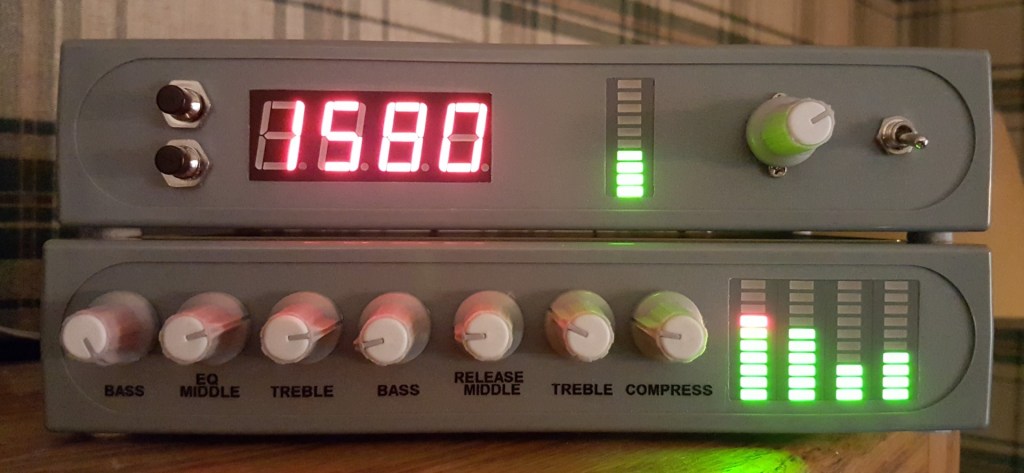
(Above: Cuthbert C-Quam AM Stereo Transmitter & Multiband Audio Processor)
Among current production radios the excellent C. Crane CC-EP-Pro offers a wide bandwidth AM setting which sounds superb, as does the vintage GE Superadio III, and several Tecsun models offer a 9 KHz bandwidth option. So, does AM sound less good today than in years past and if so, what happened? And what happened to AM Stereo? These questions are closely related as we shall see.
Wide Bandwidth and The AM Stereo Story: It is beyond the scope of this article to discuss all the details surrounding AM Stereo but a Google search of “AM Stereo” and “AM Stereo History” will provide all the detail you might want. In a nutshell, by the late 1970’s FM had become so dominant that AM stations were abandoning music in favor of talk formats. The “no static at all” refrain of the Steely Dan Song “FM” was in fact, reality. FM stereo was now standard and AM faced ever increasing electrical interference which FM was mostly impervious to, and AM’s potential to sound good was further defeated by radio manufacturers who generally reduced their AM radio’s audio bandwidth to reduce noise and to increase selectivity in the now extremely crowded AM band. In older times, with far fewer stations crowding the dial it was possible to broadcast a truly wide bandwidth 20 KHz AM signal, and radios of that day did not need to be as selective so they had wider bandwidth capabilities. Music could sound wonderful in that case.
By the mid 1970’s and 1980’s AM radio was dwindling in popularity compared with FM and AM Stereo was envisioned as a way to bring AM back as a good sounding, music-worthy medium. Unfortunately, the FCC didn’t help when they failed to adopt one standard, instead allowing four competing systems to vie for market share. Technical considerations did not favor AM as a HiFi medium and the FCC’s indecision caused confusion. The four systems were Harris, Magnavox, Kahn-Hazeltine and Motorola C-Quam which was not finally declared the official standard by the FCC until 1993, although the FCC did declare it as the standard for a brief period between 1990 – 1992. One good thing was that all four systems were backward-compatible with existing mono AM receivers. There were also enough similarities among the four systems that some compatibility existed within them…in fact, the Sony I will discuss was able to decode all four systems with only two switch selectable settings although I suspect this may have been somewhat of a compromise.
Another interesting factor surrounding the development of AM Stereo was that the radio manufacturers, for a brief moment in time, seemingly realized that if AM was ever to be considered a high-fidelity medium, one through which people might actually want to listen to music, the limited bandwidth of most current AM radios would never be successful…who cares if the sound is stereo if it is terribly muffled compared with FM and other media? Some radio manufacturers produced AM Stereo-capable receivers which had much wider bandwidth offering more extended high frequency response than the typical 1970’s – 1980’s AM radio, including quality component tuners from companies like Carver, Sangean, Sony and others and there were also some wideband mono radios as well. When signals were strong and clear, AM Stereo could indeed seemingly rival FM by car or portable radio standards. Unfortunately, AM’s inherent susceptibility to interference and fading when signals were less than perfect remained.
AM Stereo, while exciting under good conditions could not compete with FM under more typical, variable reception conditions, and together with the confusion over competing systems, gradually faded from the scene. But I was interested in seeing how good it could be under ideal conditions and to answer once and for all the question about whether or not AM Stereo could actually sound better than FM…a claim I had serious doubts about.
So, before we get into whether or not AM Stereo can sound better than FM, let’s discuss how good FM is. Over the course of my broadcast career, I have had the opportunity to work at many AM and FM stations and I can attest to the fact that the FM off-air signal can sound incredibly close to the source material when the processing is not overdone. The biggest differences by far are caused by audio processing, not the FM process itself. The issue is that some (perhaps most) modern FM stations are grossly over-processed in order to sound louder and bigger and at some of them the off-air audio is (intentionally) drastically different than what is coming out of the studio console. There are still some FM broadcasters who try to keep their sound as pure as possible – many NPR and classical music stations demonstrate FM sound at its best. The point is that if the processing is adjusted judiciously FM can sound extremely close to the original so it seemed unlikely AM Stereo could possibly sound better…in fact, if it sounded substantially different in any way it would have to be less close to the original. But I’m getting ahead of myself.
Enter the Sony SRF-A1 and Realistic TM-152 AM Stereo Radios:
The first thing I did was to scan my usual AM stations on the Sony and what I found intrigued me. The first thing I found was that this is one heck of a sensitive AM radio for its Walkman size. As I quickly scanned the AM band, I was frankly astounded by how good it is with weak stations coming in surprisingly well. And the sound was very wideband and crisp with great high frequency extension on some stations. Of course, as they say there is no free lunch and I soon found one major problem…an internally generated spurious signal blanks out a portion of the band centered at about 1 MHz. I did take a look inside for anything obvious such as a broken ground lead or missing shield but I found none, and I later learned that other samples of this model exhibit the same problem. Oh well, it’s still great on most of my usual AM stations.
Then I switched it to AM Stereo mode and got my second surprise…the radio switched into AM Stereo mode even with no Stereo signals present and the sound blossomed in an initially impressive way. It was not only louder but it had a random stereo effect that was interesting but not true to the original, with the two channels obviously somewhat out of phase with each other. I could manipulate this effect as I tuned across the signal. (Remember, at this point I was still listening to mono stations). At night the Sony’s super wide bandwidth caused lots of interstation whistles and whines…it clearly is too wide for typical nighttime listening except where your desired station is quite strong and in the clear, although on those it did sound wonderful….almost FM-like when conditions are right, including with my home transmitters. Just don’t switch it to stereo mode unless a stereo station is available.
I then tuned to my own C-Quam home transmitter and the sound was quite nice with great stereo separation and with frequency response that extended to the limits of my earphones and hearing. When the signal was clear the sound through my earphones was almost indistinguishable from FM, so to simulate less than ideal reception I waited until nighttime, then moved far enough away from the transmitter so as to make the signal weaker, and I began to hear the interference associated with the crowded AM band.


Realistic TM-152 Receiving AM Stereo Signal
I discovered that the Radio Shack TM-152 has a less wide bandwidth filter than the Sony…I would guess it to be closer to 6 KHz or so. It also is more typical in that it will not go into stereo mode unless it senses a stereo signal and the stereo indicator lights. Because it is not as wide bandwidth as the Sony it did not sound quite as crisp with good signals but it produced less noise on weaker signals. None of this was a surprise as I am used to several wideband radios and find that, in general, although the wider bandwidths do indeed make good signals sound much closer to FM quality it is often necessary to use a lower bandwidth setting when signals are weaker or interference-ridden. This is commonly known to anyone who listens to AM or Shortwave and is why most SW radios feature multiple bandwidths.
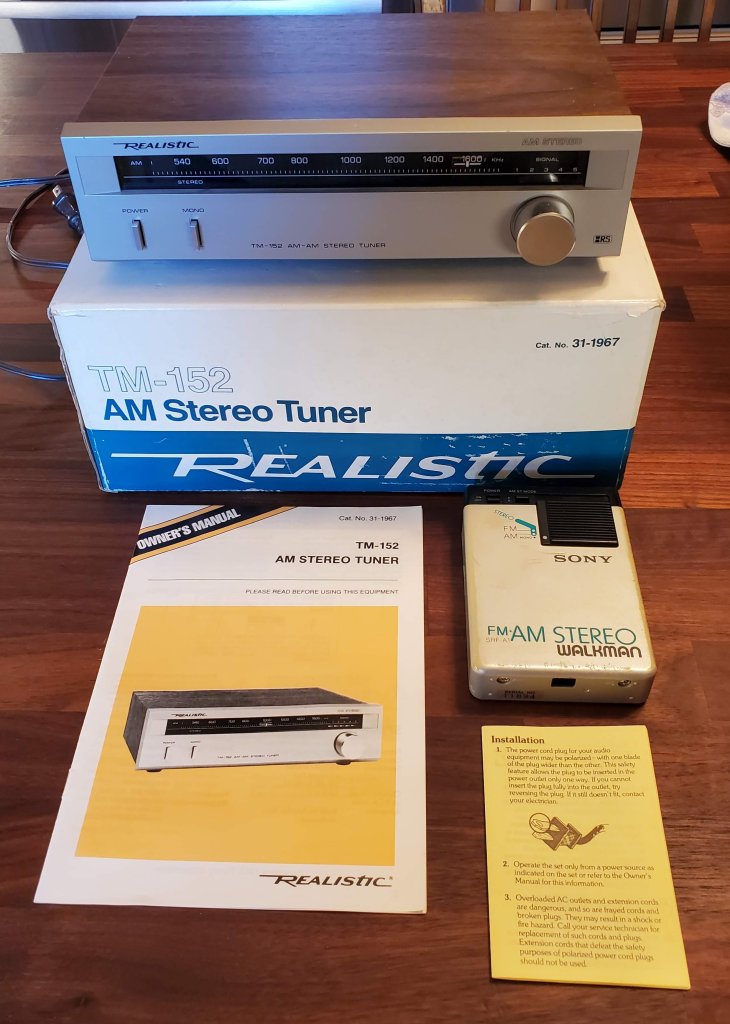
This brings up the considerations of the trade-offs between wide bandwidth for extended high frequency response versus reduction of noise and interference and in 1991 the Electronic Industries Association (EIA) and the National Association of Broadcasters (NAB) proposed the AMAX certification program for AM broadcasters and radio manufacturers.

It specified in part:
Wide audio bandwidth, with a minimum of 7,500 hertz for home and automotive radios, and 6,500 hertz for portables.
Bandwidth control, either manual or automatic, including at least two settings, such as “narrow” and “wide”.
Attenuation of the 10,000 hertz “whistle” heterodyne.
Provision for connecting an external AM antenna.
Effective noise blanking, for home and automotive receivers
Unfortunately, although the FCC endorsed it, it never because a requirement and it never caught on.
One very important point is that if you are going to have a wideband AM receiver it is vital to also incorporate a narrower bandwidth option for times when the wide bandwidth produces too much extraneous noise and interference. The Sony SRF-A1 lacks a narrow bandwidth setting but most other wideband radios do. I will say that wideband AM, especially in stereo can sound wonderful and is indeed better than narrow band AM, but for those who once claimed that AM stereo sounded better than FM you only have to look at the frequency response limitations to see that is impossible.
What About Other (non-stereo) Wideband AM Radios:
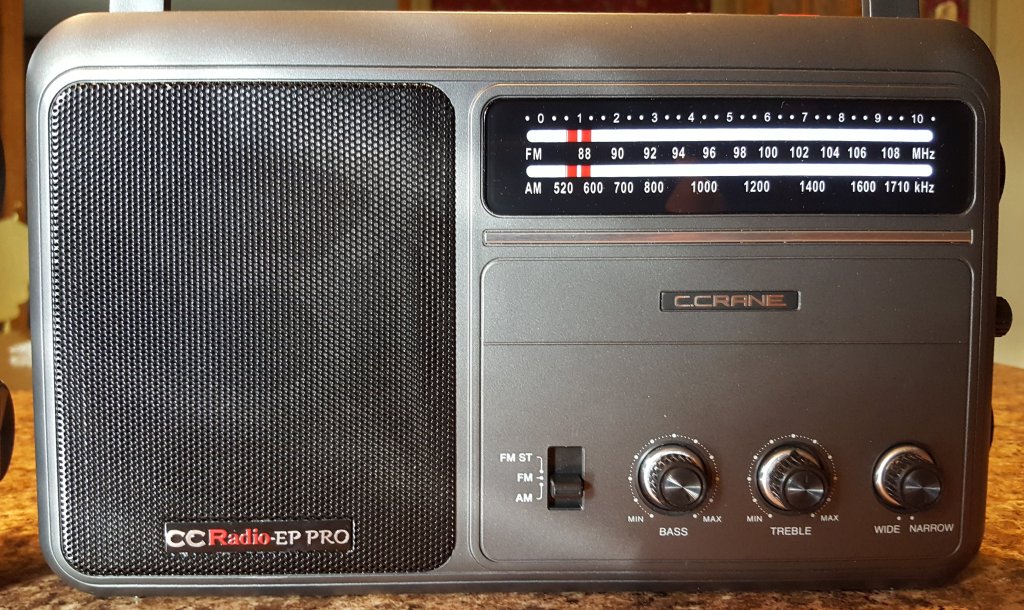
In terms of listening through a radio’s own speaker the two best sounding wideband radios I have are the C.Crane CC EP-Pro and the GE SR III (not a favorite overall but great sound especially in Wide mode)…these two have excellent audio and make AM sound like FM (by portable standards) when signals are clear. These two also sounded excellent when I listened through reference quality studio monitor handphones, which is how I tested the below radios since their speakers have limited frequency response.
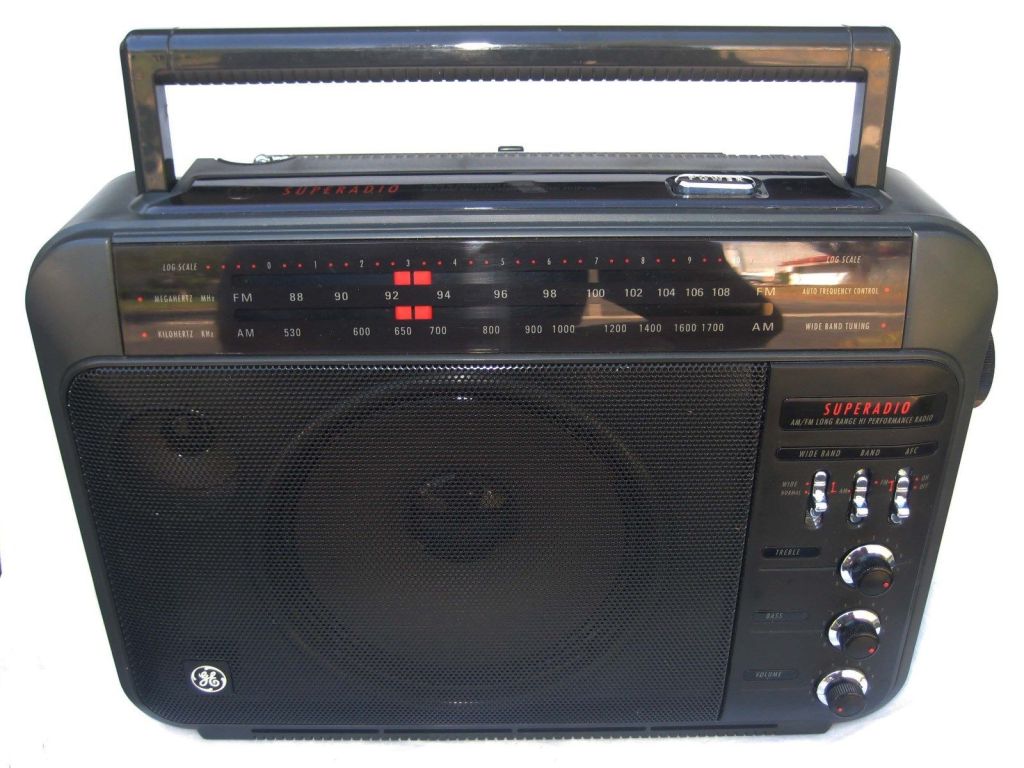
(Vintage GR Superadio III with Wideband AM)
I tested a few Tecsun radios which have a 9 KHz bandwidth setting but none of these had the sort of high frequency response I would expect of a 9 Hz filter. This is interesting because the EP-Pro claims its Wide filter is 6 KHz yet it obviously had far more extended treble frequency response than the Tecsuns set to 9 KHz. Although I’m sure their IF bandwidths are as claimed I surmise that the audio was being restricted elsewhere. I believe in specs as a rule but when listening results differ it generally means that some relevant characteristic is not being measured so at this point I have to go with what my ears tell me. I also made some frequency response checks on the test bench and they bore out what I was hearing
As for the Aiwa FR-C30U/FR-C33 (these are the same radio with or without the NOAA Weather Band) this one is an oddity. It was marketed as being Wideband and says so right on the front of the dial. Its speaker is way too limited to reveal its audio bandwidth, but listening through headphones I found the high frequency response very limited unless I off-tuned a bit which of course is not unusual. I admit I am mystified about this radio…it is cute and nice enough overall but not wideband whatsoever.
*Update: A reader just explained the apparent mystery about the AIWA thusly: “AIWA and couple of others labeled their radios that would tune in the X-BAND “wideband”. It had nothing to do with bandwidth, but rather that it could tune up to 1700.” Mystery solved.
The State of the (AM) Art in 2020:
I rounded out these tests by doing online research, consulting with an experienced broadcast engineer buddy of mine to get his take on the current state of things, and finally scanning the AM band to see what these variable bandwidth radios could do with actual broadcasts available in my area. As for current AM broadcasting standards, US stations are currently limited to a 10 KHz bandwidth but few if any go that far, most limiting themselves to 7 or possibly 9 KHz max. IBOC stations are limited to 5 KHz, all iHeart stations are limited to 5 KHz, and my casual band scans revealed that only a few seemed much wider than 6-7 KHz or so. Several Tecsun radios with a 9KHz filter sound crisper on that setting than on their 5 KHz setting on several stations, as does my CC EP-Pro, GE SR III and others, so it is clear some stations have audio response beyond 5-6 KHz but we know none now extend beyond 10 KHz by FCC mandate.
Does AM Stereo Sound Better than FM? No, and it’s not technically practical for it to sound as good. Even if there was no sideband interference from a crowded AM dial, and even if the FCC then allowed stations to go wider than the current 10 KHz limit (FM covers up to 15 KHz), you would still have the original problems of AM fading and ever-increasing noise from modern electrical devices from light dimmers to washing machines which is why the industry migrated to FM in the first place. Both the broadcast industry and the radio manufacturers realized, as stated in the AMAX proposed standards, that under less-than-idea conditions a narrow bandwidth option was needed and that would reduce high frequency response noticeably compared with FM. We do have a handful of radios available now that can provide relatively wideband AM audio under ideal conditions but I do think that many of today’s radios, such as my car radio, should be a less filtered than they are. Unfortunately, that seems unlikely because no one today is thinking in terms of how AM could sound, and although there are rules governing devices which create AM interference, they don’t seem to be effective as background noise levels seem to be increasing.
My take is that it makes most sense to think about AM in terms of its natural strengths, rather than trying to make it something it isn’t. AM does offer something FM can’t and that is transmission distance beyond the line-of-sight. Even in the daytime but especially at night AM still has that magical ability to let you hear stations far removed from your local area and for me that is what AM radio is all about.
Jay Allen
You must be logged in to post a comment.